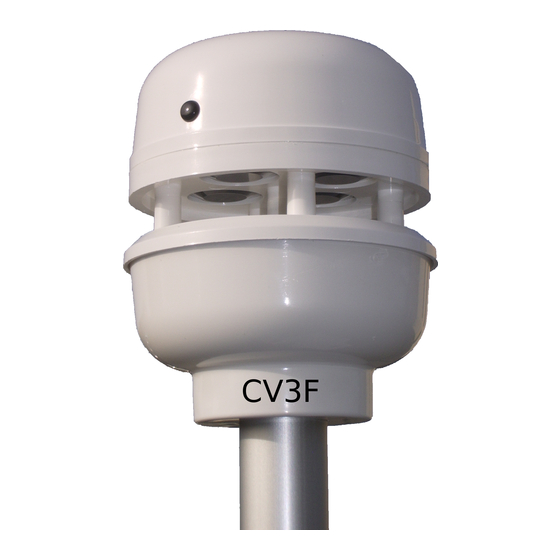
Table of Contents
Advertisement
Quick Links
CV7 is an updated wind sensor based on the CV3F series, already having a world
wide distribution. It is light, compact and has a small consumption.
CV7 is designed to fit the specific needs of sailing boats through an easy to use
programmable interface.
The sensor can be combined with a P.C., either with normalised NMEA
equipment or with any specialised equipment having common interface.
In PC mode, this bi-directional sensor can be programmed and configured for: angle
correction, smoothing time constants, measurements units and interface formats.
• Robust
• No ageing
• Robustesse
• Insensible to the gyroscopic effect
• Absence d'usure
• Sensibility stability to light winds
• Insensibilité à l'effet gyroscopique
• Minimum of resistance
• Stabilité de la sensibilité aux vents faibles
•
Compensation of inclination due to wind
• Prise au vent minimisée
•
Effet de l'inclinaison sous le vent compensé
LCJ CAPTEURS - Z.A. le Chêne Ferré – 44120 VERTOU – France
www.lcjcapteurs.com - Tel/ Fax : +33 (0)2 40 05 08 55 – info@lcjcapteurs.com
CV7
ULTRASONIC WIND SENSOR
SARL au capital de 38112 € - APE : 7490B – SIRET 424 933 075 00022
®
input
Scale 1/1
Advertisement
Table of Contents

Summary of Contents for LCJ CAPTEURS CV3F series
- Page 1 ULTRASONIC WIND SENSOR CV7 is an updated wind sensor based on the CV3F series, already having a world wide distribution. It is light, compact and has a small consumption. CV7 is designed to fit the specific needs of sailing boats through an easy to use programmable interface.
- Page 2 Principle of operation: how the equipment works The sound, the ultrasonic sound is conveyed by the movement of the fluid in which it crosses. The electroaccoustic transducers communicate between themselves two by two by ultrasonic signals determine, following the orthogonal axes, the wave transit time differences induced by the air flow The measurements are combined in an integrated calculator in order to establish the wind module and its direction in relation to a reference axis.
- Page 3 Summary Installation NMEA 0183 Interconnexions » NX2 NEXUS or FI30 FURUNO «WIND DATA Instrument interconnexions NX2 NEXUS or FI30 FURUNO «SERVER» Interconnexions FI50 (Fi501) FURUNO Interconnexions CV7 configuration Piercing gauge...
- Page 4 Installation Determine a place free from obstacles to the wind, generally at the top of the mast. Direct the stirrup of fixation so that CV7 is steered forward to the ship. Fix the stirrup following the drillings defined by the joined size. A better precision of the axis can be obtained by using the program of correction of angle.
- Page 5 » NX2 or FI30 interconnexions «WIND DATA Instrument + Power source 12 VDC (10 to 14VDC) with fusible - Power source 0 V NEXUS WIND LOG 1 2 3 4 +12VDC Blue Green Yellow NX2 or FI30 «SERVER» Interconnexions SCREEN 13 WHITE 14 YELLOW 15 GREEN 16...
- Page 6 FI50 (Fi501) FURUNO Interconnexions + Power source 12 VDC (10 to 14VDC) Black - Power source 0 V WIND NMEA 2000 NMEA 2000 12VDC FI 501 OptFI50 interface FI50 FI50 Cable Dir1 2 Brown Green Dir2 Green 3 Red Yellow Speed Yellow 4 Orange...
- Page 7 CV7 configuration CV7 is delivered with the following configuration : NMEA0183® Filtering: 2 s Forces of wind unity : Nds Temperature unity: ° C Adjustment of the angle of the wind: 0° To choose other parameters, use the downloadable software on this website: www.lcjcapteurs.com.
- Page 8 Piercing gauge...




Need help?
Do you have a question about the CV3F series and is the answer not in the manual?
Questions and answers